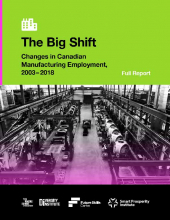The Big Shift: Changes in Canadian Manufacturing Employment, 2003 to 2018, examines disemployment through both an industry and an occupational lens. It determines which manufacturing sector industries and occupations lost workers and explores those which may have absorbed those displaced. It examines which demographic groups were particularly affected by disemployment, and whether those groups experienced worsened labour market outcomes than the general population.
Key Takeaways
- Canadian manufacturing jobs lost since 2003 were only partially replaced with comparable ones in the construction, wholesaling, and trucking industries in the major metropolitan centres of Toronto, Montreal, and Vancouver, as well as in communities within commuting distance of these three cities.
- Because they had more manufacturing employment than the Canadian average, communities such as Miramichi, Oshawa, St. Catharines-Niagara, Prince Albert, Kitchener-Cambridge-Waterloo, and Windsor have experienced disproportionately high levels of employment disruption from the decline in manufacturing employment.
- Although the number of manufacturing jobs in Canada has changed little since 2009, there has been a shift to higher-skilled occupations within the industry. Skills training is crucial to ensure workers are qualified for those jobs in construction and manufacturing.
LIRE LE RAPPORT COMPLET EN FRANÇAIS



